



The Sinking of the Sultana
140
years later, Sultana disaster
still haunts historians
Two survivors were from Jefferson County, Ind.
Editor’s Note: Around 2 a.m. on April 27, 1865, the steamboat Sultana exploded while passing north of Memphis, Tenn., along the Mississippi River. The tragedy claimed more than 2,000 passengers’ lives, most of them recently paroled Union soldiers returning home from Confederate prison camps at the close of the Civil War. More than 400 were from Indiana, including a few survivors from Jefferson County. Largely forgotten because it occurred at the same time as Lincoln’s assassination, the Sultana disaster remains the worst shipwreck in American history. On this, the 140th anniversary of the tragedy, we present the story of the Sultana disaster.
By
Robert Gray
Special to RoundAbout
(March 2005) – It was August 1863 and the boasting
and bravado of 1861 of 30-day victories over Johnnie Reb or Billy Yank
had melted away. Reality came to the North and South through the battle
mists of Shiloh and Stones River.
 |
|
March
2005 |
The savage battles of 1861, ‘62 and ‘63 had
decimated whole regiments in both armies. These losses could be replaced
by the Union, but not by the Confederates. The young men of ages 17,
18 and 19 who enlisted in 1861 with patriotic fervor were now 20, 21
and 22 years old. Many regiments that numbered 700, 800 and 1,000 men
now mustered only 250, 350 or 400. And now there was the draft. Young
men now understood the hazard of death and maiming as they watched their
older brothers return from Shiloh, Stones River and Vicksburg.
Southeast Indiana had a particular alarm in July 1863 when Gen. John
Hunt Morgan crossed the Ohio River at Harrison County and raided and
pillaged across several Indiana counties. Madison, Ind., was “sieged”
for several days, but Morgan was bluffed away and moved his troops eastward
toward Ohio.
The risks were well known by two young men of Jefferson County, Ind.,
who enlisted as “Recruit Replacements” in September 1863.
They were young – 16 and 17 years – too young to
enlist in 1861 during the patriotic bravado that marked the outset of
the Civil War.
Romulus Tolbert, 16, and John C. Maddux, 17, farmed in Saluda Township,
in western Jefferson County, and in July 1863 both joined what was soon
designated the 8th Indiana Cavalry as “Recruit Replacements.”
The two young men would share an incredible series of events unique
to only a few who fought and died in that terrible conflict. Both men
were assigned to Co. H of the 8th Cavalry. Tolbert was first engaged
at the Union disaster at Chickamangua Creek, Ga., in late September
1863.
It took the Union Army more than three months to lift the siege of Union
forces after Chickamangua. Tolbert and Maddux, who went to the 8th Cavalry
Regiment directly after Chickamangua, were in continuous cavalry picket
service from Stevenson, Ala., to Browns Ferry, Tenn., during the siege
that lasted until January 1864. Then the Union Army was re-organized
and reinforced under Gen. William Tecumseh Sherman and headed south
toward Atlanta.
The 8th Indiana Cavalry was engaged continuously during the summer months
of ‘64 along the Western and Atlantic Railroad south from Chattanooga
to Atlanta. The unit was vital to Sherman’s army in protecting
his supply line as he advanced on Atlanta. The 8th Indiana Cavalry skirmished
with rebel raiders almost daily and there were daily casualties.
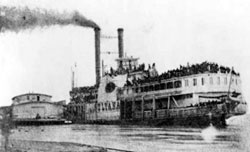 |
|
This is the most famous photo of the Sultana, taken April 25, 1865, in Helena, Ark., just two days before the disaster. |
Sherman moved his army ever southward against Gen. Joseph
Johnston’s Rebels. In rapid succession, there was Ressca, Dalton,
Lovejoy Station, New Hope Church, Kennesaw Mountain. Confederate President
Jefferson Davis replaced Johnston with Gen. John Bell Hood, but on Sept.
1, 1864, Atlanta fell. Hood’s Rebel army was in shambles and was
forced southward and westward away from Atlanta.
Sherman and Grant conferred and decided Sherman would move his main
Union Army eastward, and this became the famous “Sherman’s
March to the Sea.” Most of the 8th Indiana Cavalry remained behind
to face the remnants of Hood’s Rebels and to protect the ever longer
supply lines between Chattanooga and Atlanta. This involved sharp, nasty
and deadly skirmishes, particularly along the Western and Atlantic Railroad.
One of these skirmishes was centered south and west of Atlanta near
Jonesboro, Ga., in mid-September 1864.
Tolbert was riding with Maj. Thomas Graham in a 50-man patrol near Cannelton,
Ga., in what was referred to as the “Kilpatrick Raids.” The
unit was attacked by Confederate Raiders from ambush near Owl Rock Church,
eight miles east of Cannelton. Tolbert was seriously wounded, and three
others of the regiment were killed. The Yankees were forced to retreat,
and Tolbert was captured.
Tolbert, seriously wounded, was taken to Cannelton and held in a private
residence for more than a week. After shot was removed from his jaw
and back, he was taken to a hospital facility in Montgomery, Ala., where
he remained confined for six weeks. About Nov. 1, Tolbert was taken
to Cahaba, Ala., and confined in the Cahaba Military Prison on the banks
of the Alabama River as a convalescing wounded.
Union skirmishing with Hood around Atlanta continued, and on Oct. 27
in a sharp action along the Western and Atlantic Railroad, Pvt. Maddux
was taken prisoner at Marietta, Ga. Maddux was also taken to Cahaba
Prison (dubbed Castle Morgan by the prisoners) and arrived in its confines
about the same time as the injured Tolbert.
Grueling life at the Cahaba Prison
The Cahaba Prison facility was formed in mid-1863 from a commandeered
half finished warehouse owned by one Col. Hill. The building had only
a partial roof and bunks were built six high to accommodate 660 men.
The structure was brick and measured 200 x 120 with a board stockade,
12 feet high enclosing an area of 15,000 square feet. Guards paced on
a plank walkway at the top of the stockade wall. The prison was serviced
by a six-hole privy, which exhausted into the Cahaba River, just west
of a confluence with the smaller Cahaba River. Cahaba had a number of
Artesian wells that offered continuous running water into the prison
building and hence to the privy.
Food at Cahaba prison was mostly rough ground corn meal, usually including
cobs and stalks and occasionally low-grade pork and rarely, rice. The
“New Yawker” gangs could sometimes have beef and cane sugar
as supplement from their illicit trade with the guards.
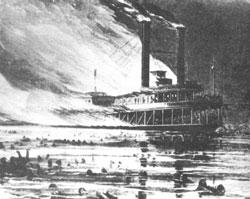 |
|
Photo courtesy of www.sultanadisaster.com This
oil painting of the Sultana |
Maddux and Tolbert were dangerously exposed in one respect.
hey were “occasional” prisoners in a sea of squads and whole
regiments (the 3rd Tennessee Regiment captured on Sept. 23, 1863, by
Confederate Gen. Nathan Bedford Forest). This made them vulnerable to
“Raiders” and “New Yawkers.”
As with many military prisons, Cahaba held a number of predatory gangs.
New prisoners were soon relieved of their ready cash, watches, boots
and blankets. These were then traded by the predators to the prison
guards for extra food, soap, etc. These predator gangs were referred
to as “New Yawkers” as it was thought that most of these predators
came from Hookers “up east,” soldiers that had come to Sherman’s
army after the Union defeat at Chickamauga. There was a tacit approval
of these inmate predators by the rebel provost since they profited from
the thievery from newer prisoners, and the beaten and subdued prisoners
were thus less trouble.
Fate smiled kindly on Tolbert and Maddux in the person of “ Tennessee.”
“Big Tennessee” had been a wagon master in the 3rd Tennessee
Infantry. The “New Yawkers” had tried their predations on
soldiers in the 3rd Tennessee Regiment who were captured in late ‘63.
Big Tennessee was a large man, near seven-foot tall, barrel chested
and muscular, yet strangely kind by nature. He became a champion of
the oppressed. When the prison predators challenged “Big Tennessee,”
there was no contest and at the first outing with the New Yawkers, “Big
Tennessee” badly injured three “New Yawkers.” Then routinely,
“Big Tennessee” befriended many “occasional prisoners”
in Cahaba.
While at Cahaba Prison, the fate of Union soldiers lay with two Confederate
officers. By a strange fluke of command structure, Capt. Howard “H.A.M.”
Henderson had direct command of the prison, while Lt. Col. Sam Jones
commanded the prison guard and the Cahaba military district.
Henderson was a kind natured, even benevolent and caring Methodist minister
who sincerely tried to manage the prison as benignly as possible. On
the other hand, Jones was an embittered Louisiana regimental commander
who had surrendered to Grant at Vicksburg and was paroled.
Cahaba had a well run hospital facility that had been established in
the Bell Tower Hotel two blocks up Vine Street from the prison stockade.
The hospital treated both wounded Confederates as well as Union prisoners
at “Castle Morgan.” Tolbert could continue convalescence while
Maddux could be treated for diarrhea, which he had developed from the
rough and insufficient prison food. The hospital at Bell Tower listed
a daily population of 225 as the prison population drifted to more than
2,700 in early 1865.
Overcrowding, sickness, misery
By late 1864, as the population steadily rose, daily fare for prisoners
at Castle Morgan averaged per man only one quart of ground raw corn
(including cob and husks), one ounce raw pork or beef (often rancid),
occasional dried peas, and, rarely, rice. The men could sometimes supplement
food rations by trading with the guards. There was no cooking facility,
and the men were organized into 10 men messes, with one man from each
mess allowed outside the stockade once a day to cook. Cooking was over
an open fire in a bucket held on a stick.
Capt. Henderson worked continuously to better the situation for the
prisoners, and after extensive negotiations with Union Gen. Cadwalleder
Washburn, 2,000 each of shirts, pants, blankets, mess tins as well as
medicine came to Cahaba via steamer in mid-December 1864.
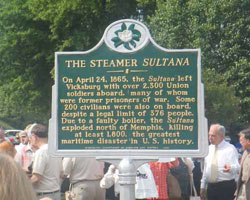 |
|
Photo by Bill Strong of www.phototour.com A
Vicksburg, Miss., marker |
Sadly, the relief shipment was soon bartered away to the
Confederate guards since the pressing need of the prisoners was food.
Thus, the men at Cahaba went into the winter months poorly clothed for
the uncommonly severe winter months of January and February. Suffering
in the crowded brick structure of the prison with only a partial roof
was severe.
The crowding rose sharply toward 3,000 men during late January and early
February 1865. The cases of scurvy and pneumonia increased. The hospital
at Bell Tower appropriated an adjoining house to accommodate the soaring
winter illnesses. Also, the inability of the Confederates to feed 3,000
men instead of a planned 660 men was evident. The ration of corn meal
fell to one pint per man per day, and any bit of bacon or beef came
very rarely.
As for Tolbert, his ability to continue his convalescence from his gunshot
wounds declined, while Maddux’s diarrhea from the rough, inadequate
food became chronic.
Still, in the midst of this increasing misery, there were acts of kindness
toward the Yankee prisoners. Amanda Gardner lived with daughter, Annabelle,
only a few yards from the stockade perimeter, and the two ladies passed
what extra food they had or could get through a hole in the stockade
boards to the desperate men. More over, the elder Gardner gathered and
passed on warm clothing to the Yankees as the hard winter weather continued.
She even cut up her floor rugs, blanket size, and passed them to the
Yankee prisoners as her gesture of mercy. But perhaps above all, Gardner
had books. She lent them without reservation to the deprived and miserable
prisoners. Even more remarkable, she had lost a son in the Confederate
Army in 1861.
In January 1865, the weather turned ever colder, but a more dangerous
event occurred on Jan. 23, 1865. Capt. Hiram Hanchett of the 16th Ill.
Cavalry and a small group of prisoners mutinied and succeeded in capturing
nine men of the prison guard inside the stockade.
An alerted Confederate outside guard succeeded in closing the outer
stockade gates. The guard commander was called – Lt. Col.
Sam Jones! Worse yet, the more moderate Capt. Henderson was away. Jones
ordered up two light artillery pieces and had them primed and loaded
and leveled through stockade ports at the 2,500 confined men in Cahaba.
The situation was on razor’s edge for an hour. Hanchett finally
gave it up, and the Confederate guards he had captured were released
from their confinement in the stockade privy.
Hanchett and his small band of mutineers were captured and confined
in a small dungeon in the Cahaba City Jail. Hanchett was probably murdered
by Lt. Jones. The mystery of Hanchett’s fate remains unresolved.
Considering the malevolent temperament of Col. Jones regarding Union
prisoners, it is surprising that Tolbert and Maddux did not die by cannon
blast at Cahaba military prison on Jan. 20, 1865.
Flood
threatens the prison
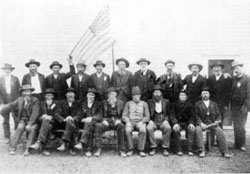 |
|
Photo
courtesy of This
photo of Tennessee survivors |
The winter continued to ravage the miserable prisoners
at Cahaba during February 1865. Maddux was in serious condition as his
diarrhea was chronic and worsening. Rom Tolbert’s wounds were incompletely
healed and his shoulder and lower jaw gave considerable pain in such
miserable circumstance.
In late February, events began to move swiftly for Maddux and Tolbert.
The winter weather abruptly abated, and the spring thaws brought a new
hazard – flood! On March 1, 1865, the Alabama River was in
flood stage. This also made for flood of the adjoining Cahaba River,
and by March 3, 1865, Cahaba prison was under three feet of water. Three-thousand
men faced drowning.
A prisoner delegation was allowed an audience with Lt. Jones, who assured
them that they may all drown as far as he cared. Sixty of the Confederate
guards under Jones’ command signed a petition to the colonel to
allow the prisoners to be confined on higher ground since they were
certainly of no escape risk in their present state of advanced disability
from malnutrition and a ravaging winter.
By March 3, providence relented, and the flood stabilized. Jones relented
and allowed small prison work details out of the stockade to gather
roots and other brush waste to be brought into the stockade. In the
days following, rest and sleep for the 3,000 confined men was on these
debris islands, rafters, bunks and the tops of the unfinished walls
of the prison shelter. The flood killed the usual running water supply,
and drinking water had to be brought in by boat.
The standing flood water within the stockade became putrid, particularly
with so many of the prisoners with persistent dysentery. The six-hole
privy was inundated, and the boards of the stockade perimeter was a
natural confinement for the flood water. The stench of human waste was
unbearable.
But momentous events same in a rush. Lee was approaching his destiny
at Appomattox. Sherman was moving up the Atlantic Coast toward Virginia.
John Wilkes Booth agreed to appear at Fords Theater in Washington, D.C.,
and, most importantly for Maddux and Tolbert, the newly promoted Lt.
Col. Henderson had secured agreement with Federal Col. A.C. Fisk to
parole and exchange men confined at Andersonville and Cahaba. The agreement
provided prisoner movement at once to Camp Fisk, five miles east of
Vicksburg, Miss.
The
long march to freedom
Tolbert and Maddux left Castle Morgan by river steamer about March 14
to Selma, Ala., where they boarded the Alabama and Mississippi Rivers
Railroad. The route was westward to Demopolis, Ala., thence to Meridian
and Jacksonville and on to Vicksburg. The rail trip was not direct since
the 700 men in Tolbert and Maddux’s draft often marched between
rail heads along the route, and the Federal soldiers marched the last
30 miles from Jackson, Mississippi toward Camp Fisk about April 10,
1865.
At last! Freedom, proper food, warm clothing and rest on clean Army
cots and recovery from a downward spiral toward death from malnutrition
and exposure while confined was a next step.
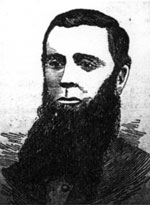 |
|
J. Walter Elliott |
The weak, emaciated prisoners were now in desperate straights,
and several of their group of 700 men had died along the way. There
were no rations for the prisoners. On the third day, exchange of prisoners
started, and Maddux and Tolbert staggered across the foot bridge spanning
the Big Black River and up the embankment to Camp Fisk. Freedom!
Federal orderlies helped the staggering wasted men to the open air commissary
where hogs’ heads were broken in and the prisoners accessed beef,
hardtack and brined cabbage. Tolbert and Maddux found themselves “absorbed”
by the soldiers of the 3rd Tennessee Infantry and “Big Tennessee,”
who was now only a wasted seven-foot tall scarecrow of a man.
About April 19, Tolbert and Maddux and others at Camp Fisk were issued
new uniforms. The sufficiency of food had worked wonders in only a few
days at Camp Fisk, but sadly, many of the newly released prisoners could
not hold down the suddenly plentiful food. Maddux was in particular
distress since his dysentery was now chronic and he could tolerate only
moderate portions of the plentifully supplied rations.
The spring rains were a plague since Camp Fisk had no shelter facility
for the wasted prisoners. The men foraged lean-to material from the
surrounding forests. Branches, logs and river reeds were used.
Capt. George Williams was preparing release rolls as quickly as possible,
and by April 20, several hundred men were sent the five miles by rail
to Vicksburg to be transported up river to Camp Chase in Ohio for discharge.
By April 20, both Union and Confederate knew the war was over, and there
was a rush to move the pitiful ranks of released men north to Camp Chase
as fast as possible.
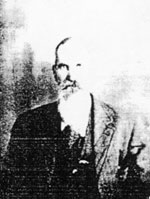 |
|
John C. Maddox |
Further, by April 20, large drafts of Union prisoners from Andersonville, Ga., were arriving at Camp Fisk. The men from Andersonville were almost all gravely debilitated, starved and emaciated, in dramatic contrast to the men from Cahaba, who although badly debilitated were dramatically better of than the men from Andersonville.
Arriving
at the river port
On the morning of April 24, 1865, Tolbert and Maddux, along with many
other Indiana soldiers (the rolls were prepared by state), were put
on a train and taken the five miles by rail to the waterfront at Vicksburg.
There were three giant river steamers ready to accept them. But oddly,
all of the prisoners were marched across the gang plank of only one
of the boats. The steamer Olive Branch had backed into the flood-swollen
Mississippi and dug its side wheels into the current headed north with
700 men just before Tolbert and Maddux arrived at the Vicksburg wharf.
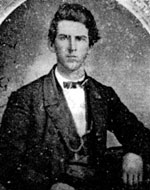 |
|
Romulus Tolbert |
The steamer Sultana had been at New Orleans on April 18,
1865, having been the vehicle that carried the news of Lincoln’s
assassination to the ports down river from Cairo, Ill. While at New
Orleans, chief engineer Wintrenger informed Capt. Cass Mason that one
of the new fangled tubed boilers was leaking. After discussions, it
was decided to head up river on the flooding Mississippi and manage
repairs at Cairo.
The Sultana had docked at Vicksburg in the evening of April 22, 1865.
Chief engineer Wintrenger told Capt. Mason that the inboard larboard
(port-side) boiler was now not only leaking but was now “warped.”
With such alarming news, Mason relented and sent for a boiler repairman
from Kleins Foundry at Vicksburg. The repairman wanted to install a
new boiler section but was overruled by Mason, who assured the repairman
and Winteger that the boiler would be repaired at Cairo. Kleins Foundry
installed a “patch” on the boiler.
Meanwhile, the Sultana business agent had been busy arranging transport
of the released Union prisoners from Camp Fisk to Camp Chase. Terms
of the negotiations were soon evident. All of the prisoners from Camp
Fisk would be boarded on the Sultana. All 1,700 or 1,800 or 2,000 – no
one ever knew for sure. The assigned limit for passengers on the Sultana
was 376.
When they boarded, the happy, homeward-bound soldiers gladly accommodated
to the grossly cramped conditions aboard the Sultana. Again, the men
formed 10 men messes and were “in place” wherever they were
assigned a billet, mostly on the exposed hurricane deck. The officers
fared better, being assigned quarters in the “grand salon”
on the boiler deck among the paying passengers.
Tolbert and Maddux, along with perhaps 2,000 other Union soldiers, crammed
every available space aboard their steamer, and by 3 p.m, the Sultana
backed into the flooded Mississippi and headed upriver, bearing happy,
relieved, sick Union soldiers toward home. Tolbert and Maddux were assigned
space on the boiler deck with barely enough room to lie down on blankets,
but nevermind, they were headed home!
Trouble on board
Within two hours of the voyage on the flooded Mississippi, it was necessary
for the ship’s company to wedge giant timbers under the floor of
the hurricane deck, since the deck flooring was dangerously sagging
from the weight of 1,000 men now quartered there (many of the 3rd Tennessee
and “Big Tennessee”).
The following day, April 25, the Sultana put in for ship's business
at Helena, Ark. It was here that a photographer was on a wharf boat
and set up to photograph the happy home-bound soldiers. Many of the
1,000 soldiers on the hurricane deck wanting to “be in the picture”
moved en mass to larboard. The boat listed 20 degrees, and a frightened
Capt. Mason begged the officers to move the soldiers to their assigned
billets to help right the listing boat.
When the Sultana arrived at the wharf boat in Memphis on the evening
of April 26, 1865, the inboard larboard boiler was again inspected,
and the patch seemed to be holding satisfactorily.
About midnight, the Sultana raised steam and moved across the flooded
Mississippi River to an Arkansas coaling yard, where the happy home-bound
soldiers helped the ship’s company load aboard more than 1,000
sacks of coal, enough for the upriver voyage to Cairo, Ill. Cairo was
to be a stopover on the way to Camp Chase, Ohio, where the prisoner
veterans expected quick release from their wartime service and their
captivity at Andersonville and Cahaba prison camps.
The steamer left the Arkansas coaling station about 1:30 a.m. on April
27, 1865. Many of the euphoric, just released Union prisoners had about
30 more minutes to live. A few more had several hours more to live,
while a pitifully few would survive the coming horror.
The Sultana crossed the flooded Mississippi and established up river
headway, close to the Tennessee side of the river. The Sultana steamed
six miles up river when a huge explosion occurred.
Perhaps 200 souls were blown immediately into the flooded river. Some
were badly scalded as well. Maybe 50 more had crowded around the boilers
for warmth in the unseasonably cold night. These were dead instantly
from the blast and scald. The blast created an immediate fire threat.
The flames were visible for many miles at Memphis, in Arkansas and upriver
to approaching down river bound steamers. Panic ensured, and 700 or
800 people jumped into the flooded river. Although panic prevailed and
memories failed with time, Tolbert and Maddux were probably among these
first victims into the river. The sudden mass of men in the water took
down even the competent swimmers among them, but Tolbert and Maddux
separated from the stricken and doomed mass and floated down river toward
Memphis with the debris.
There was a fitful effort on board to organize “bucket brigades”
to douse out the ever-spreading flames, now gaining momentum from fore
to aft. But spreading panic prevailed, and all but the prow area of
the packet was soon fully enveloped in flame. As the inferno moved quickly
aftward, even more souls chose to jump into the water rather than burn
to death.
The fire horror had mostly run its course by 3:30 a.m., when the destroyed
hulk grounded close to a bank on the Arkansas side of the river, about
three miles down river from the explosion site. Thirty-five people were
saved from the still-burning prow of the craft in Arkansas. Alerted
rescue brigades of citizen boaters and canoeists were now in the river
and along the flooded banks looking for survivors. The Navy and other
boats from Memphis were also now helping. The grounded Sultana burned
to the water level and sank below the surface of the flooded Mississippi
within minutes of the removal of the last injured survivors from the
prow of the boat.
It is undetermined how many died in the disaster, but the Sultana still
remains far and away America’s worst inland marine disaster ever.
More people were lost on the Sultana than the Titanic sinking in 1912.
Life after the disaster
Besides Maddux and Tolbert, Jefferson County, Ind., had a number of
other citizens on the Sultana. Among them were father-and-son James
Safford Sr. and James Safford Jr. The elder Safford was a member of
the Christian Commission, while his son was enlisted in the 10th Indiana
Cavalry.
Capt. James Walter Elliott, born in “South Hanover,” also
survived, and it was an injured Elliott who organized a large contingent
of Indiana and Ohio prisoner survivors of the Sultana disaster and saw
them safely to Cairo and Indianapolis and Columbus, Ohio. It was Elliott
who intervened with Indiana Gov. Oliver P. Morton in fastracking the
Saffords, Tolbert and Maddox back to Jefferson County. The latter two
arrived in Madison by rail on May 6, 1865.
The Saffords moved from the county soon after the war’s end, but
both Tolbert and Maddox continued their lives in Jefferson County and
both lived well into their 70s. Tolbert is buried in the New Bethel
Cemetery in Saluda Township, while Maddux was buried on the family farm.
Slowly, the terrible memories dimmed for those who experienced the terror,
pain and agony of that night in April, 1865, on the flooded Mississippi
and lived to tell about it. The national news accounts of the disaster
also faded quickly. In fact, the disaster made only incidental and marginal
news.
America was simply swamped with other momentous news during April 1865.
Lincoln was assassinated and the funeral cortege took three weeks to
cross the country from Washington, D.C., to Springfield, Ill. John Wilkes
Booth was slain in a barn in Virginia. Lee surrendered at Appomattox.
Confederate Gen. Joe Johnson surrendered soon after Lee, effectively
ending the Civil War.
Military inquiries into the cause of the Sultana disaster were only
lightly covered by the newspapers of the day. So America’s greatest
inland marine disaster became mostly a historical footnote to the American
Civil War.
• Robert Gray, 77, resides in Saluda Township in western Jefferson County, Ind.